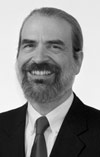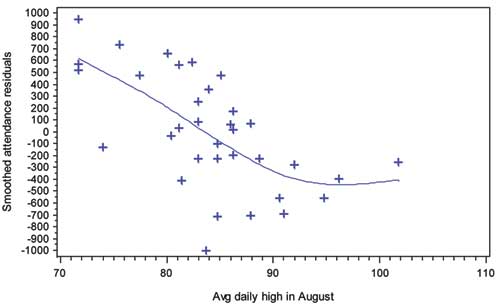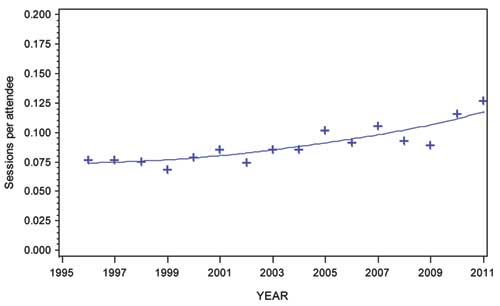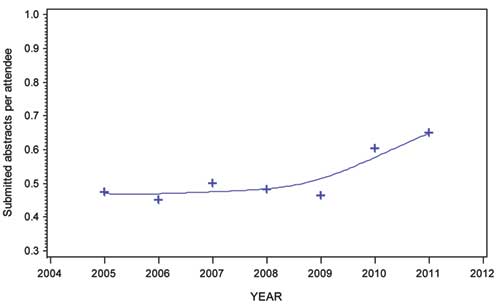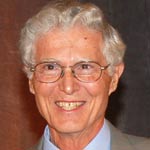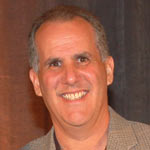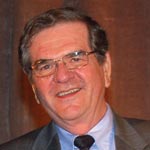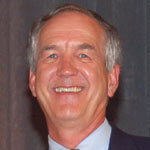JSM 2011 Highlights & Trends
Click here to view pictures from JSM 2011.
David R. Judkins, JSM 2011 Program Chair
We will not know for several months what you, the participants, thought of the technical program. I do hope you completed your questionnaires if you were selected. Response rates dropped sharply for the 2010 attendee survey—26% is pretty bad for a profession that loves numbers. This, of course, is our main tool for monitoring how we are doing and deciding what alterations to consider for future years.
Although I loved the job, I was not looking forward to Florida in August. I loved Vancouver and wish we could meet there every year. A number of people I tried to recruit for sessions declined because of the site. As it turned out, I enjoyed swimming in the evenings out in the shallows, but I decided to see how well attendance is predicted by historical average daily high in August. It turns out it is a powerful predictor. For every one degree of Fahrenheit, we lose 43 attendees.
I first fit a model for attendance with a linear time trend and indicator variables for Washington, DC, and Canada. Attendance always spikes in DC, while there are many difficulties for U.S. federal employees and green card holders getting to Canada. However, attendance is higher in Canada. This is because of the temperature advantage in August. When I plot the residuals from this model against the temperature variable and smooth the results, a very clear pattern emerges (Figure 1). We lose hundreds of attendees by booking convention centers in sweltering cities.
Figure 1. Attendance residuals in terms of average daily high
Even those who do attend don’t like being someplace hot in August. Satisfaction with the convention city was far lower for Salt Lake City than for Vancouver or Seattle. For Salt Lake, 37% were highly satisfied with the site selection. The comparable figures for Seattle and Vancouver were 86% and 83%, respectively. Given this pattern, I was pleased to learn that policies for the selection of convention cities have changed. The next few years look very pleasant: San Diego, Montréal, Boston, Seattle, and Chicago.
Another interesting issue about JSM is the growth in the ratio of technical sessions to attendees (Figure 2). A growing proportion of attendees are presenting. We set a new record in Miami Beach for this ratio. We had 600 fewer attendees than Vancouver, but only 11 fewer technical sessions. Figure 3 shows submitted abstracts per attendee. It doesn’t go back as many years, but shows a major bump in the
last two.
Figure 2. Sessions per attendee by year
Figure 3. Submitted abstracts per attendee by year
I don’t think this is a healthy trend for our societies. We need to rent larger convention centers to host all those lectures, which puts upward pressure on the registration fee for all and makes for longer distances to walk between sessions. If there were some way to encourage people to attend without presenting, it would help hold the registration fee in check.
I want to thank the Committee on Meetings and 2011 ASA President Nancy Geller for entrusting me with this job. I really enjoyed the experience. Next, I’d like to thank the General Methodology chairs, Andrew Gelman and Brian Wiens; the poster chair, Benmei Liu; the whole JSM committee; and ASA staff for working so hard with me to make the technical program in Miami Beach a success.
For years, we have been trying to encourage poster presentations, since they require less space, but the attendee survey shows that only about one-third of attendees view the posters. This compares to 80%–85% percent who attend at least one invited session; 85%–90% who attend at least one contributed session; 10%–20% who attend introductory overview lectures, late-breaking sessions, and college bowl sessions; and 85%–90% who visit the exhibit hall. If most attendees will not view the posters, then we cannot expect them to be a popular choice. Given that space for a poster costs much less than space for a lecture, we probably need to add free goodies of some type to the poster sessions.
The other popular idea is to referee papers. That would be a lot of work and tend to favor well-known authors. It seems the easiest thing would be to tax contributed paper presenters with a high registration fee. So far, this idea has gone over like a lead balloon. Something needs to be done, though. If this trend continues for many more years, we are likely to run out of convention centers that can satisfy our need for lecture hall space.
Many Honored at Presidential Address, Awards Ceremony
Highlighting the ASA Presidential Address and Awards Ceremony during the Joint Statistical Meetings in Miami, Florida, were the announcement of the Founders Award winners and the official induction of 58 ASA Fellows. Congratulations to all.
Founders
Wayne Fuller, Iowa State University, for being an outstanding role model and a mentor to many ASA members for more than 50 years; for his exemplary service to ASA through his leadership on various committees— including Strategic Planning, Review of Long-Range Financial Policy, Census Blue Ribbon Panel, Appointments to Federal Statistics Positions, Selection of ASA Fellows and Awards, and USDA Advisory—and for his invaluable contributions to a number of editorial boards, sections, and the board of directors.
Nat Schenker, CDC, for outstanding leadership and service well above the call of duty during two terms on the ASA Board, including one term as vice president; for his leadership as JSM program chair; for chairing the JSM Task Force, which had a significant positive impact on JSM; for chairing the Meetings Workgroup that led to the creation of the new Conference on Statistical Practice; for serving as chair of the Government Statistics Section; and for service on the Committee on Publications.
William Smith, Lecot, Inc., for exceptional service as executive director of the ASA from 2001–2007; for providing extraordinarily skillful leadership of the ASA’s acquisition and renovation of a new headquarters; for reorganizing the ASA office for better coordination of statistical education activities; for expanding and improving the Joint Statistical Meetings; for overseeing the provision of electronic journal access to ASA members; and for obtaining federal funding for ASA programs.
Bob Starbuck, for his commitment to partnerships among industry, academe, and government, as demonstrated by his commitment to the SPAIG Committee and other ASA entities that has spanned two decades; for his service to the Biopharmaceutical Section in several roles, including as chair; for his leadership of the Deming Lectureship Committee; for his contributions to the development of the undergraduate statistics education guidelines; and for his service to and leadership of the Committee on Fellows, including his regular reporting of data about the Fellows process to members.
Fellows
Each year, ASA Fellows are nominated by the membership and selected by the ASA Fellows Committee, chaired this year by Starbuck. The number of Fellows named is limited to no more than one-third of 1% of the active ASA member total. The following 58 ASA Fellows were inducted this year:
Keith A. Baggerly, MD Anderson Cancer Center
Kenneth A. Bollen, The University of North Carolina at Chapel Hill
Tim Bollerslev, Duke University
Robert Francis Bordley, General Motors
Connie M. Borror, Arizona State University West
Tianxi Cai, Harvard University
Joseph C. Cappelleri, Pfizer Inc.
Ivan Siu Fung Chan, Merck & Co.
James J. Cochran, Louisiana Tech University
Bruce A. Craig, Purdue University
Michael R. Elliott, University of Michigan
Brenda L. Gaydos, Eli Lilly and Company
Amanda L. Golbeck, University of Montana
Paul Gustafson, University of British Columbia
J. Michael Hardin, University of Alabama
Dominique M. A. Haughton, Bentley University and Université Toulouse I
David M. Higdon, Los Alamos National Laboratory
Susan Galloway Hilsenbeck, Baylor College of Medicine
Alan D. Hutson, University at Buffalo, SUNY
J. T. Gene Hwang, Cornell University
Patricia A. Jacobs, Naval Postgraduate School
Zhezhen Jin, Columbia University
Grace E. Kissling, National Institute of Environmental Health Sciences
Eric D. Kolaczyk, Boston University
Kalimuthu Krishnamoorthy, University of Louisiana at Lafayette
Anthony Y. C. Kuk, National University of Singapore
Kenneth L. Lange, University of California at Los Angeles
Peter J. Lenk, University of Michigan
Runze Li, The Pennsylvania State University
Faming Liang, Texas A&M University
John C. Liechty, Penn State University
Aiyi Liu, National Institute of Child Health and Human Development
Ying Lu, VA Cooperative Studies Program Palo Alto Coordinating Center and Stanford University
Esfandiar Maasoumi, Emory University
Ranjan Maitra, Iowa State University
Matthew Stuart Mayo, University of Kansas Medical Center
Jeffrey S. Morris, MD Anderson Cancer Center
Christopher J. Nachtsheim, University of Minnesota
Deborah A. Nolan, University of California
Dimitris N. Politis, University of California at San Diego
J. Sunil Rao, University of Miami
Jerome P. Reiter, Duke University
Charles J. Rothwell, NCHS/CDC
Venkatraman E. Seshan, MSKCC
Thomas A. Severini, Northwestern University
Arvind K. Shah, Merck Research Laboratories
Lori A. Thombs, University of Missouri
Paul A. Tobias, Statistical Consultant
Julia Volaufova, LSU Health Sciences Center
Sue-Jane Wang, CDER, FDA
Michel Wedel, University of Maryland
Herbert I. Weisberg, Correlation Research, Inc.
Robert G. Wilkinson, The Lubrizol Corporation
Fred A. Wright, The University of North Carolina
Minge Xie, Rutgers, The State University of New Jersey
Lijian Yang, Michigan State University
Donglin Zeng, The University of North Carolina
Hongtu Zhu, The University of North Carolina at Chapel Hill
Many more people were honored for their contributions to various causes that advance the field of statistics. Following is a list of awards and recipients:
Samuel S. Wilks Memorial Award
The Samuel S. Wilks Memorial Award was established in 1964 to honor the memory and distinguished career of Sam Wilks by recognizing outstanding contributions to statistics that carry on the spirit of his work. The 2011 Wilks award winner is Nan M. Laird of Harvard University School of Public Health. She was honored for her pioneering work on the EM algorithm, which set the foundation for many subsequent advances in computational statistics and biology.
Gottfried E. Noether Awards
The Noether awards were established in 1999 by the wife and daughter of the late Gottfried Emanuel Noether of the University of Connecticut as a tribute to his memory. They recognize distinguished researchers and teachers and support research in nonparametric statistics. The Gottfried E. Noether Young Researcher Award winner for 2011 is Ying Wei, from Columbia University, for outstanding early career contributions to nonparametric statistics. The Gottfried E. Noether Senior Scholar Award winner for 2011 is Jon Wellner, from the University of Washington, for his outstanding contributions to the theory, application, and teaching of nonparametric statistics.
Statistics in Chemistry Award
The Statistics in Chemistry Award recognizes outstanding collaborative efforts between statisticians and chemists. While this is a section award, the board of directors grandfathered it in 1995 for presentation at the ASA Presidential Address and Awards Ceremony. The 2011 Statistics in Chemistry Award was presented to Thomas Brendan Murphy, Nema Dean, and Adrian E. Raftery for their paper “Variable Selection and Updating in Model-Based Discriminant Analysis for High-Dimensional Data with Food Authenticity Applications,” published in Annals of Applied Statistics.
Outstanding Statistical Application Award
Each year, the ASA recognizes a paper that is an outstanding application of statistics in the physical, biological, or medical sciences. This year’s winners are Adrian Raftery, Miroslav Kárný, and Pavel Ettler for extending Bayesian methods for model uncertainty to temporally evolving systems and showing how these ideas can be successfully applied to solving a challenging problem in a continuous manufacturing system.
Edward C. Bryant Scholarship Award
The Bryant scholarship trust is a permanent scholarship fund endowed by Westat to honor its cofounder and longtime leader, Edward C. Bryant. The award honors an outstanding graduate student who is studying survey statistics. The 2011 scholarship recipient is Anne-Sophie Charest from Carnegie Mellon University.
W. J. Dixon Award for Excellence in Statistical Consulting
Established through a gift from the family of Wilfrid Dixon, this award recognizes outstanding contributions to the practice of statistical consulting. The 2011 award went to Michael Kutner of Emory University in recognition of his long and distinguished career as a collaborative biostatistician, his contributions to instruction in applied linear models, and his widespread influence and advocacy for high standards in statistical applications in the medical sciences.
W. J. Youden Award
The W. J. Youden Award in Interlaboratory Testing was established in 1985 to recognize the authors of publications that make outstanding contributions to the design and/or analysis of interlaboratory tests or describe ingenious approaches to the planning and evaluation of data from such tests. The 2011 Youden Award went to Ryan Browne, Jock MacKay, and Stefan Steiner in recognition of their paper, “Leveraged Gauge R&R Studies,” published in Technometrics.
Waller Education Award
Retired ASA Executive Director Ray Waller and his wife, Carolyn, established the Waller Education Award in 2002 to recognize a statistics teacher early in his/her career for excellence and innovation in teaching introductory statistics at the undergraduate level. The 2011 Waller award winner is Michelle Everson in recognition of her outstanding contributions to and innovation in the teaching of elementary statistics.
SPAIG Award
The ASA established the SPAIG Award in 2002 to recognize outstanding partnerships between academe and business, industry, and government organizations and to promote new partnerships. It is the only ASA award that recognizes organizations. This year’s SPAIG award was given to Nationwide Center for Advanced Customer Insights, The Ohio State University, and Insights and Analytics Nationwide Insurance Company.
Gertrude M. Cox Scholarships
Tanya Pamela Garcia of Texas A&M University and Emma Rudié of Stanford University are the winners of the 22nd annual Gertrude M. Cox scholarships. Since 1989, the Cox scholarship has been awarded by the ASA Committee on Women in Statistics and the Caucus for Women in Statistics to encourage women to enter statistically oriented professions. The following women were awarded honorable mentions: Viktoriya Krakovna of the University of Toronto; Emily Mitchell of Emory University; Ashley Petersen of the University of Washington; and Aleksandra M. Stein of the University of Nebraska, Lincoln.
COPSS Honors Statisticians
Members of the Committee of Presidents of Statistical Societies (COPSS) are pleased to announce the 2011 awards, which were presented to the winners at JSM in Miami Beach, Florida, by COPSS president, Xihong Lin.
The winner of the Presidents’ Award is Nilanjan Chatterjee of the National Cancer Institute for outstanding contributions to the statistical sciences by ingenious methodological research with applications in epidemiology and genetics, including studies of gene-environment interactions, disease heterogeneity, and genome-wide association studies; for fundamental contributions to the theory of case-control studies and complex retrospective sampling designs; for demonstrating leadership and a vision as a statistical scientist by actively collaborating in wide-ranging studies of cancer epidemiology and genetics and concurrently maintaining a vigorous methodological research program closely tied to cutting-edge scientific issues; and for exceptional mentoring and service to the profession and to the National Cancer Institute.
Chatterjee is also the winner of the Snedecor award for his contributions to biometric research and his paper, “Shrinkage Estimators for Robust and Efficient Inference in Haplotype-Based Case-Control Studies,” published in the Journal of the American Statistical Association.
The F. N. David award was presented to Marie Davidian of North Carolina State University for important contributions to the development of methods for analyzing data from longitudinal studies and clinical trials and for outstanding leadership and dedication to the statistical profession.
The 2011 Fisher Lecturer was C. F. Jeff Wu of Georgia Institute of Technology. He was chosen for fundamental contributions to the planning, analysis, and interpretation of statistical studies that have had a profound impact on the practice of statistics, especially in engineering. This includes significant results on resampling methods and theory of experimental design and pioneering work in industrial statistics that has changed the way statistical studies are used to optimize products and processes. His lecture was titled “Post-Fisherian Experimentation: From Physical to Virtual.”
Click here for award criteria and nominating procedures.

